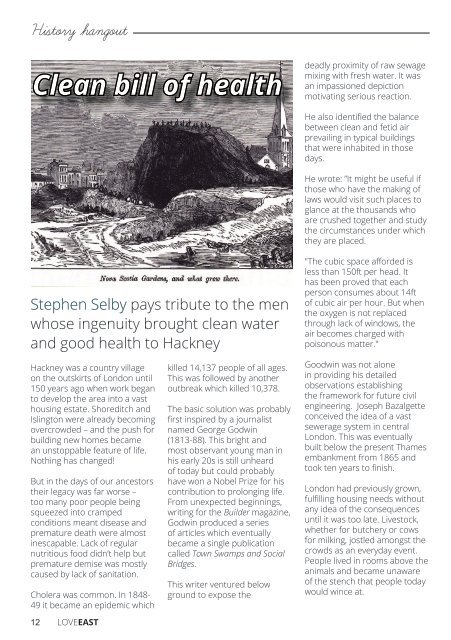April 2017
You also want an ePaper? Increase the reach of your titles
YUMPU automatically turns print PDFs into web optimized ePapers that Google loves.
History hangout<br />
Clean bill of health<br />
deadly proximity of raw sewage<br />
mixing with fresh water. It was<br />
an impassioned depiction<br />
motivating serious reaction.<br />
He also identified the balance<br />
between clean and fetid air<br />
prevailing in typical buildings<br />
that were inhabited in those<br />
days.<br />
He wrote: ”It might be useful if<br />
those who have the making of<br />
laws would visit such places to<br />
glance at the thousands who<br />
are crushed together and study<br />
the circumstances under which<br />
they are placed.<br />
Stephen Selby pays tribute to the men<br />
whose ingenuity brought clean water<br />
and good health to Hackney<br />
Hackney was a country village<br />
on the outskirts of London until<br />
150 years ago when work began<br />
to develop the area into a vast<br />
housing estate. Shoreditch and<br />
Islington were already becoming<br />
overcrowded – and the push for<br />
building new homes became<br />
an unstoppable feature of life.<br />
Nothing has changed!<br />
But in the days of our ancestors<br />
their legacy was far worse –<br />
too many poor people being<br />
squeezed into cramped<br />
conditions meant disease and<br />
premature death were almost<br />
inescapable. Lack of regular<br />
nutritious food didn’t help but<br />
premature demise was mostly<br />
caused by lack of sanitation.<br />
Cholera was common. In 1848-<br />
49 it became an epidemic which<br />
killed 14,137 people of all ages.<br />
This was followed by another<br />
outbreak which killed 10,378.<br />
The basic solution was probably<br />
first inspired by a journalist<br />
named George Godwin<br />
(1813-88). This bright and<br />
most observant young man in<br />
his early 20s is still unheard<br />
of today but could probably<br />
have won a Nobel Prize for his<br />
contribution to prolonging life.<br />
From unexpected beginnings,<br />
writing for the Builder magazine,<br />
Godwin produced a series<br />
of articles which eventually<br />
became a single publication<br />
called Town Swamps and Social<br />
Bridges.<br />
This writer ventured below<br />
ground to expose the<br />
"The cubic space afforded is<br />
less than 150ft per head. It<br />
has been proved that each<br />
person consumes about 14ft<br />
of cubic air per hour. But when<br />
the oxygen is not replaced<br />
through lack of windows, the<br />
air becomes charged with<br />
poisonous matter."<br />
Goodwin was not alone<br />
in providing his detailed<br />
observations establishing<br />
the framework for future civil<br />
engineering. Joseph Bazalgette<br />
conceived the idea of a vast<br />
sewerage system in central<br />
London. This was eventually<br />
built below the present Thames<br />
embankment from 1865 and<br />
took ten years to finish.<br />
London had previously grown,<br />
fulfilling housing needs without<br />
any idea of the consequences<br />
until it was too late. Livestock,<br />
whether for butchery or cows<br />
for milking, jostled amongst the<br />
crowds as an everyday event.<br />
People lived in rooms above the<br />
animals and became unaware<br />
of the stench that people today<br />
would wince at.<br />
12 LOVEEAST

















